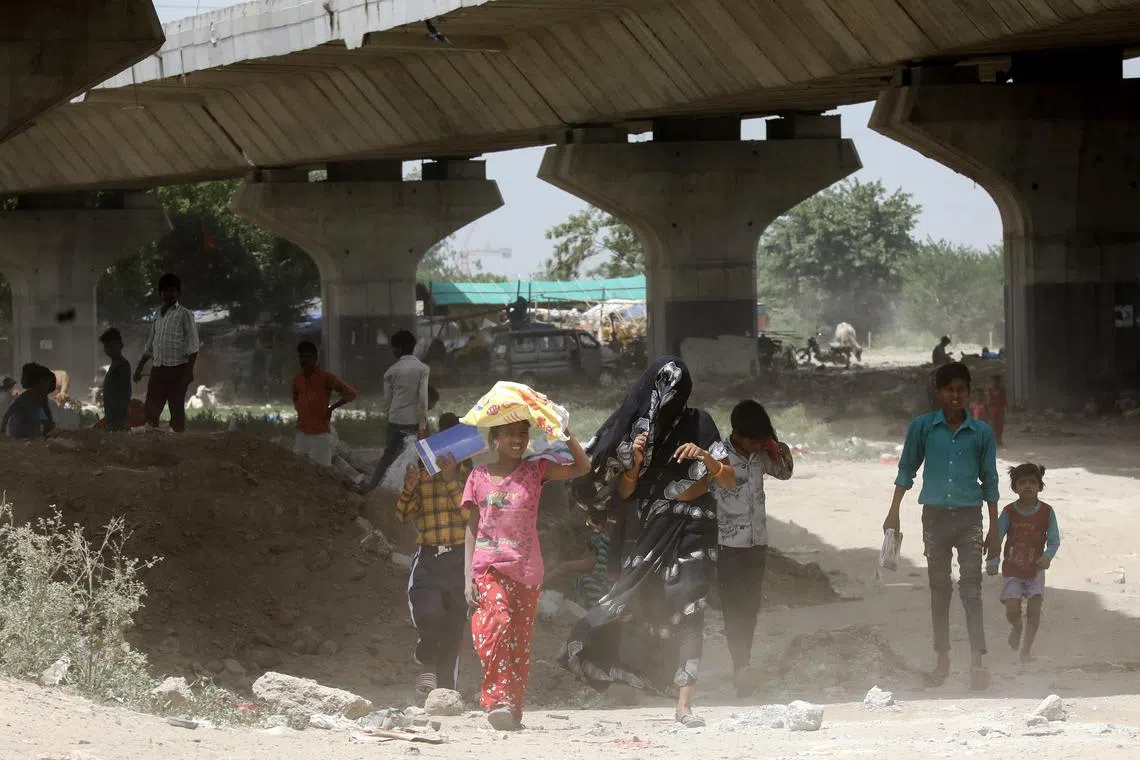Northern India endures a heatwave, and a wave of deaths
Sign up now: Get ST's newsletters delivered to your inbox

Officials are investigating what role the dangerous combination of heat and humidity played in the rise in mortality.
PHOTO: EPA-EFE
Follow topic:
NEW DELHI – An unusually intense heatwave has swept across northern India in the past four days, with some hospitals in the state of Uttar Pradesh recording a higher-than-usual number of deaths.
Doctors there are convinced there is a link between the punishing temperatures and the deaths of their patients.
But officials are investigating what role the dangerous combination of heat and humidity played in the rise in mortality.
In Ballia district, which has a population of about three million people, the daily high temperature over the past four days has hovered at around 43 deg C – 9 deg C hotter than usual.
Relative humidity has been as high as 53 per cent.
Dozens of deaths were recorded at hospitals in the area on June 15, 16 and 17.
Dr Jayant Kumar, chief medical officer of Ballia district, near the state of Bihar, said that 23 people died in the district on Thursday. The next day, 11 more succumbed.
“The number of deaths has been more than normal,” Dr Kumar said.
He told the Press Trust of India, a news agency, that on average, eight people usually die per day.
“Most of these are natural deaths”, he told The Times in a phone interview, “most of the dead being elderly people suffering from different ailments like diabetes”.
But Indian government officials have pushed back against linking the deaths too directly to the punishing heat.
Dr Diwakar Singh, formerly the chief medical superintendent of Ballia district, told reporters on Friday night that 34 people had died of heatstroke at the main hospital under his oversight.
The next day, he was reprimanded by the state government for prematurely drawing that conclusion and removed from his position.
The government has since sent a scientific team from the state capital, Lucknow, to investigate the causes.
Dr Singh’s replacement, Dr S.K. Yadav, took a more cautious line on Sunday, saying: “Elderly patients with comorbidities like hypertension and diabetes are expiring because of heat.”
But he later added: “Still, the death numbers are more than normal.”
He agreed with Dr Kumar’s assessment that the excessive heat was to blame for the high death toll, whatever the exact link.
While an extraordinary number of patients had been admitted for heat-related distress, Dr Yadav said: “We are able to provide beds to all the patients, and we have enough doctors and medicines.”
The nightmarish prospect of mass deaths caused by a sudden rise in temperatures has become more urgent in recent years. And the phenomenon in this area of the world may portend a warning beyond India’s borders.
The heat in this part of India has been hovering around the critical wet-bulb temperature, the threshold beyond which the human body cannot cool itself to a survivable point by perspiration, defined as 35 deg C, adjusted for 100 per cent humidity.
The wet-bulb reading in Ballia on Saturday reached 34.15 deg C.
It is expected that more older or infirm patients than usual will die in heatwaves like this one, which climate change has made more common across India’s historically scorching plains, as in most of the world, scientists say.
The question is whether these are “excess deaths”, of the kind that can be measured only statistically, or whether India’s incrementally more unbearable weather is playing a more direct role in causing them, for instance by heat stroke.
When more deaths are recorded than were expected, they count as excess. But that leaves open the question of what exactly caused them.
Local newspapers, collecting figures from different officials and hospitals, have counted as many as 54 deaths in Ballia and an additional 44 in Bihar over the past three days.
In April, when temperatures in the western state of Maharashtra were nearing their peak, at least 11 people were known to have died of heat stroke almost simultaneously.
The fact that wet-bulb temperatures in much of South Asia have been inching nearer to the critical level has provoked global concern over the past few years. It has even made its way into literature.
The Ministry For The Future, a science-fiction novel by author Kim Stanley Robinson in 2020, imagines a scenario in which 20 million Indian citizens living in the same part of the country – men, women and children – are killed by an intense heatwave within one week, immediately changing the course of history.
The region’s hottest weather breaks in June every year.
A cyclonic storm, the Indian Ocean equivalent of a hurricane, pushed through India’s western coast late last week, and its rains are expected to arrive in Uttar Pradesh and Bihar within the next two days.
That should bring temperatures down from their highest level. Soon after, the region can expect the annual monsoon. NYTIMES

